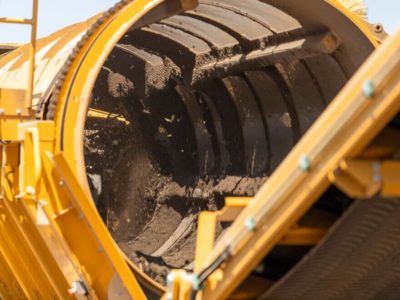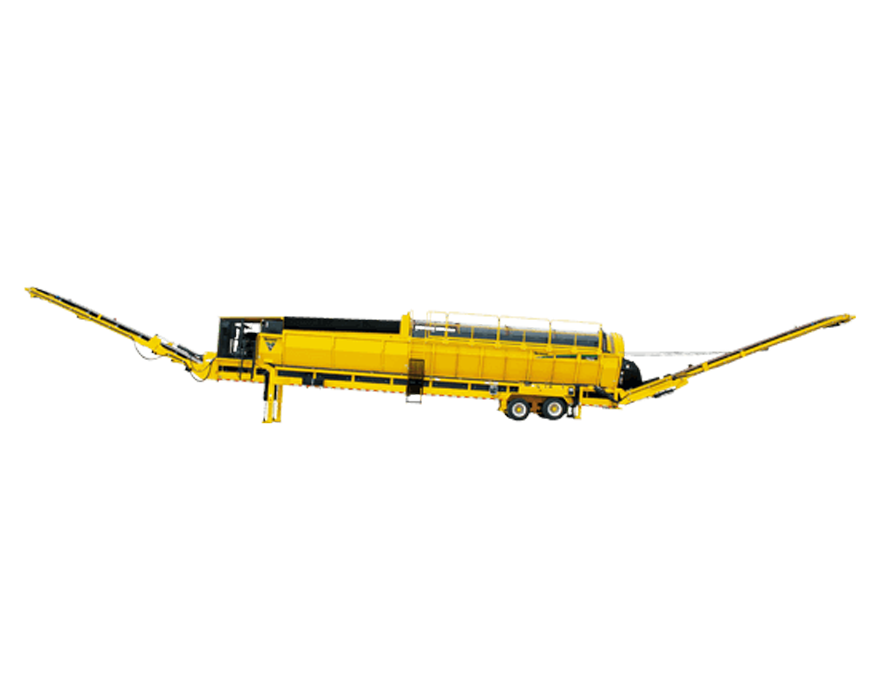Trommel screens are designed to separate a wide variety of materials by size such as compost, soil, sands, gravel, light aggregate and sludge. If you regularly use a grinder for mulch chippings and want to maximize productivity and minimize machine wear, consider adding a Vermeer trommel screen to your fleet.
Here are a few ways that adding a trommel screen can improve efficiency on a mulch operation when paired with a horizontal grinder or tub grinder.
Less double grinding
Operators who aim to create a quality mulch product are often needing to double grind to create more consistent chip sizes. An alternative to double grinding is to utilize a trommel screen on your jobsite.
When wood waste is put through a grinder, it creates small, dusty particles called fines. For a tree care company, the less fines that are in the finished mulch product, the better. Ted Dirkx, Recycling and Forestry sales manager is familiar with this challenge of producing less fines, especially when it comes to colored mulch. He says, “in the mulch industry 80% of it gets colored, and fines soak up excess color additive.” Having a substantial number of fines requires additional dye to complete the coloring process, which can increase costs. If you are not coloring mulch, fines will still soak up other types of moisture. This can add unnecessary weight to the final product, making it more expensive to transport.
Double grinding creates additional fines in the finished product. Using a trommel screen alongside a grinder can create a high-quality product with few fines, by minimizing the amount of chips that need to go through the double grinding process.
Minimize machine wear
For any piece of equipment, minimizing wear on key machine components is crucial. By using a trommel screen to sort the different sizes of particles, you will no longer need to double grind the entire pile. Instead, separate the grindings through the trommel screen with the select screen size, and only double grind the oversize material that need it. This helps extend the longevity on highly wearable pieces such as hammers, screens, cutter tips and wear plates.
Dirkx knows that using a trommel is an additional step in the grinding process, which can be a hurdle for customers. He says, “it adds an extra step, but it is also decreasing the amount of material in the second grind, reducing grinder usage, and creating a high-quality end product for the customer.”
Primary ground material can often have non-wood waste material such as dirt, rocks and sand, especially with land clearing projects. Those abrasive materials can add wear on the grinder, but don’t worry — they can be screened by a trommel. Creating cleaner waste for a regrind is not only good for the finished product, but for the machine itself.
Cost considerations
It may sound contradicting that adding an extra machine can help minimize certain costs on your jobsite, but there is a clear reason: fuel consumption.
Adding a trommel screen can reduce the amount of material needing to be reground, meaning less time running the machine, and using less fuel to create a high-quality finished product. A trommel screen uses significantly less fuel to operate than a grinder. A grinder uses 20 to 40 gallons per hour, versus a trommel using two to three gallons per hour.
Adding a trommel screen to your tree waste jobsite can maximize productivity and create an efficient jobsite, in more ways than one. To get a beautiful and high-quality mulch product while minimizing grinder usage, consider adding a trommel screen to your fleet.
For more information on Vermeer trommel screens, contact your local dealer.
Vermeer Corporation reserves the right to make changes in product engineering, design and specifications; add improvements; or discontinue manufacturing or distribution at any time without notice or obligation. Equipment shown is for illustrative purposes only and may display optional accessories or components specific to their global region. Please contact your local Vermeer dealer for more information on machine specifications.
Vermeer and the Vermeer logo are trademarks of Vermeer Manufacturing Company in the U.S. and/or other countries. © 2022 Vermeer Corporation. All Rights Reserved.

